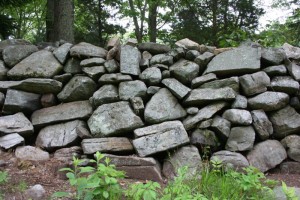Looking back on 45+ years of scientific research I see three overlapping phases of primary interest.
Geoarchaeology: Beginning in 1973, my early work on Arctic paleolithic archaeology, paleoecology, and paleoclimatology culminated with the 1982 founding of the Alaska Quaternary Center, and my chairing of the Geological Society of America’s Archaeological Geology Division, and my authorship in the 1990 Geological Society of America Decade of North America review volume Archaeological Geology of North America. I continue to help advise graduate students in UConn’s Department of Anthropology, where was jointly appointed from 1990-2019. Geoarchaeology remains one of my key scholarly interests. I am equally interested in historical archaeology (mainly via the stone domain) and pre-historic archaeology (mainly via Quaternary stratigraphy. Below are PDF files of two examples:
- 2023 – My most recent archaeological paper is a sole-authored, peer-reviewed, mini-monograph for Historical Archaeology titled Taxonomy and Nomenclature for the Stone Domain in New England. ” Link here…“
- 2014 – An alternative stratigraphic model for geoarchaeology of the Connecticut River floodplain for the journal Quaternary International is “Hydraulic Back-flood model for the archaeological stratigraphy of the Connecticut River Alluvial Lowland, central Connecticut ,USA. Link here….
Glacial Tectonics: In 1976 I began working on the glacioisostatic flexure and crustal tilting of western Washington, and the paleo-seismicity of New England and Puget Sound. After publication in Science, this work was put on hold for a decade, resumed with several grants from the U.S. Geological Survey’s National Earthquake Hazards Program in the mid 1990s, and has returned to my desktop for publication. An invited article in 2000 for Quaternary Science Reviews reviewed the field of Glacial Tectonics.
Anthropocene: My mid-career work on the origin and development of New England’s upland stone walls and lowland freshwater wetlands was part of a broader trend in geosciences that treats Homo sapiens as the dominant geologic agency on planet Earth. The wetland work featured the archetype small New England catchment of Susquetonscut Brook in Lebanon, CT. Increasingly, I’m working to make the investigation of New England stone walls a scientific endeavor, and to interest ecologists in examining this, largely overlooked signature phenomenon.
What has not changed over the years is the mantra my students chant to all my courses: “No rock. No ecosystem. No culture.” Indeed, all of human culture is supported by ecosystems, all of which depend on the solid earth –what Henry David Thoreau called the “living rock.”
Photo: Historic stone wall in Guilford, CT dominated by locally derived gneiss. Stone size and arrangement suggests an early farm boundary, perhaps late 18th century.
